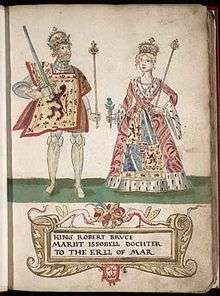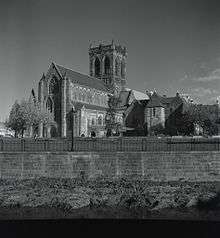Marjorie Bruce
| Marjorie Bruce | |
|---|---|
| Princess of Scotland | |
 Marjorie Bruce's sarcophagus-effigy at Paisley Abbey, where she was buried | |
| Born | 1296/7 |
| Died | 2 March 1316 (aged 19–20) |
| Burial | Paisley Abbey |
| Spouse | Walter Stewart, 6th High Steward of Scotland |
| Issue | Robert II of Scotland |
| House | Bruce |
| Father | Robert I of Scotland |
| Mother | Isabella of Mar |
| Religion | Roman Catholic |
Marjorie Bruce or Marjorie de Brus (1296/7 – 2 March 1316) was the eldest daughter of Robert the Bruce, King of Scots by his first wife, Isabella of Mar. Her marriage to Walter, High Steward of Scotland gave rise to the House of Stewart. Her son was the first Stewart monarch, King Robert II of Scotland. Her widowed father later married Elizabeth de Burgh.
Early life

Her mother, Isabella, was a noblewoman from the Clan Mar. Soon after giving birth to Marjorie, at the age of nineteen, Isabella died.[1] Her father was at that time the Earl of Carrick. Marjorie was named after her father's mother, Marjorie, Countess of Carrick.
According to legend, her parents had been very much in love, and Robert the Bruce did not remarry until Marjorie was six years old. In 1302, a courtier named Elizabeth de Burgh became her stepmother.
On 27 March 1306, her father was crowned King of Scots at Scone, Perthshire,[1] and Marjorie, then nine years old, became a Princess of Scotland.
Imprisonment (1307–1314)
Three months after the coronation, in June, 1306, her father was defeated at the Battle of Methven. He sent his female relatives (his wife, two sisters and Marjorie) north with his supporter Isabella MacDuff, Countess of Buchan, but by the end of June they were captured by Earl of Ross, a Balliol supporter, who handed them over to the English.[1]
As punishment, Edward I of England sent his hostages to different places in England. Princess Marjorie went to the convent at Watton; her aunt Christina Bruce was sent to another convent; Queen Elizabeth was placed under house arrest at a manor house in Yorkshire (because Edward I needed the support of her father, the powerful Earl of Ulster, her punishment was lighter than the others'); and Marjorie's aunt Mary Bruce and the Countess of Buchan were imprisoned in wooden cages, exposed to public view, Mary's cage at Roxburgh Castle and Countess Isabella's at Berwick Castle. For the next four years, Marjorie, Elizabeth, Christina, Mary and Isabella endured solitary confinement, with daily public humiliation for the latter two. A cage was built for Marjorie at the Tower of London, but Edward I reconsidered and instead sent her to the convent.[2] Christopher Seton, Christina's husband, was executed.
Edward I died on 7 July 1307. He was succeeded by his son, Edward II, who subsequently held Marjorie captive in a convent for about seven more years. She was finally set free around 1314, possibly in exchange for English noblemen captured after the Battle of Bannockburn (23 June – 24 June 1314).
Marriage and death

Walter Stewart, 6th High Steward of Scotland distinguished himself in the battle and was rewarded the hand of the adolescent princess. Her dowry included the Barony of Bathgate in West Lothian. The original site of Bathgate Castle, which was part of the dowry, can be found on the grounds of Bathgate Golf Club. The site is protected by the Historic Scotland organisation and the Club is debarred from carrying out any excavation work on the site without prior permission. Every year on the first Saturday of June, the town of Bathgate celebrates the marriage of Marjorie and Walter in their annual historical pageant, just before the town's procession and Newland festival. Local school children are given the parts of Marjorie, Walter and other members of the court. After the pageant, everyone joins the procession along with Robert the Bruce on horseback.
Two years later, on 2 March 1316, Marjorie was riding in Gallowhill, Paisley, Renfrewshire while heavily pregnant. Her horse was suddenly startled and threw her to the ground at a place called "The Knock." She went into premature labour and her child, Robert, was delivered by Caesarean section at Paisley Abbey. Marjorie died within a few hours.
She was nineteen at the time of her death, like her mother, who was also nineteen years old when she died in childbirth.
At the junction of Renfrew Road and Dundonald Road in Paisley, a cairn marks the spot near to where Marjorie reputedly fell from her horse. The reputed place of her death is now referred to as Knockhill Road, with nearby roads of Bruce Way, and Marjorie Drive named in her honour. She is buried at Paisley Abbey.
Her son succeeded his childless uncle David II of Scotland in 1371 as King Robert II. Her descendants include the House of Stuart (or Stewart) and all their successors on the throne of Scotland, England and the United Kingdom.
Ancestry
| Ancestors of Marjorie Bruce | ||||||||||||||||||||||||||||||||||||||||||||||||||||||||||||||||||||||||||||||||||||||||||||||||||||||||||||||||||||||||||||||||||||||||||||||||||||||||||||||||||||||||||||||||||||||||||||||||||||||||||||||||||||||||||||||||||||||||||||||||||||||||||||||||||||||||||||||||||||||||||||||||||||||||||||||||||||||||||||||||||||||||||||||||||||||||||||||||||||||||||||||||||||||||||||||||||||||||||||||||||||||||||||||||||||||||||||||||||||||||||||||||||||||||||||||||||||||||||||||||||||||||||||
|---|---|---|---|---|---|---|---|---|---|---|---|---|---|---|---|---|---|---|---|---|---|---|---|---|---|---|---|---|---|---|---|---|---|---|---|---|---|---|---|---|---|---|---|---|---|---|---|---|---|---|---|---|---|---|---|---|---|---|---|---|---|---|---|---|---|---|---|---|---|---|---|---|---|---|---|---|---|---|---|---|---|---|---|---|---|---|---|---|---|---|---|---|---|---|---|---|---|---|---|---|---|---|---|---|---|---|---|---|---|---|---|---|---|---|---|---|---|---|---|---|---|---|---|---|---|---|---|---|---|---|---|---|---|---|---|---|---|---|---|---|---|---|---|---|---|---|---|---|---|---|---|---|---|---|---|---|---|---|---|---|---|---|---|---|---|---|---|---|---|---|---|---|---|---|---|---|---|---|---|---|---|---|---|---|---|---|---|---|---|---|---|---|---|---|---|---|---|---|---|---|---|---|---|---|---|---|---|---|---|---|---|---|---|---|---|---|---|---|---|---|---|---|---|---|---|---|---|---|---|---|---|---|---|---|---|---|---|---|---|---|---|---|---|---|---|---|---|---|---|---|---|---|---|---|---|---|---|---|---|---|---|---|---|---|---|---|---|---|---|---|---|---|---|---|---|---|---|---|---|---|---|---|---|---|---|---|---|---|---|---|---|---|---|---|---|---|---|---|---|---|---|---|---|---|---|---|---|---|---|---|---|---|---|---|---|---|---|---|---|---|---|---|---|---|---|---|---|---|---|---|---|---|---|---|---|---|---|---|---|---|---|---|---|---|---|---|---|---|---|---|---|---|---|---|---|---|---|---|---|---|---|---|---|---|---|---|---|---|---|---|---|---|---|---|---|---|---|---|---|---|---|---|---|---|---|---|---|---|---|---|---|---|---|---|---|---|---|---|---|---|---|---|---|---|---|---|---|---|---|---|---|---|---|---|---|---|---|---|---|---|---|---|---|---|---|---|---|---|---|---|---|---|---|---|---|---|---|---|---|---|---|---|---|---|---|---|---|---|---|---|---|---|---|---|---|---|---|---|---|---|---|---|---|---|---|---|---|---|---|---|---|---|---|---|---|---|---|---|---|---|---|---|---|---|---|---|---|---|---|---|---|---|
| ||||||||||||||||||||||||||||||||||||||||||||||||||||||||||||||||||||||||||||||||||||||||||||||||||||||||||||||||||||||||||||||||||||||||||||||||||||||||||||||||||||||||||||||||||||||||||||||||||||||||||||||||||||||||||||||||||||||||||||||||||||||||||||||||||||||||||||||||||||||||||||||||||||||||||||||||||||||||||||||||||||||||||||||||||||||||||||||||||||||||||||||||||||||||||||||||||||||||||||||||||||||||||||||||||||||||||||||||||||||||||||||||||||||||||||||||||||||||||||||||||||||||||||
Marjorie in fiction
The young adult novel Girl in a Cage by Jane Yolen and Robert J. Harris features Marjorie Bruce as its protagonist. In it, Marjorie is imprisoned in a cage. Although there is a preface stating that it is fictional, many have taken it to be a true story.
In 2016 the historical fiction novel Spirit of Fire: The Tale of Marjorie Bruce was first published. The novel written by young author, Emmerson Brand, features Marjorie Bruce as its main protagonist. The novel is set in medieval Scotland and while having elements of fiction, Spirit of Fire is based on the real events of Marjorie's life.
References
- 1 2 3 "Elizabeth de Burgh and Marjorie Bruce". Foghlam Alba
- ↑ Scott, Ronald McNair, Robert the Bruce, p. 87
External links
- Bannockburn article (National Trust for Scotland) contains some information on Marjorie Bruce.
- Bathgate Castle and Old Hall Knowe
